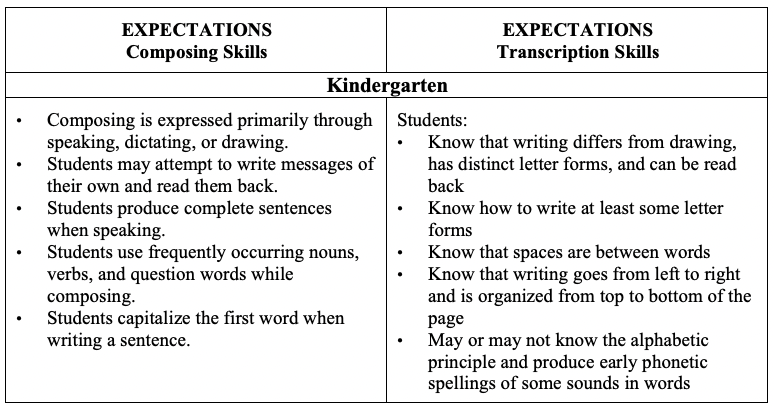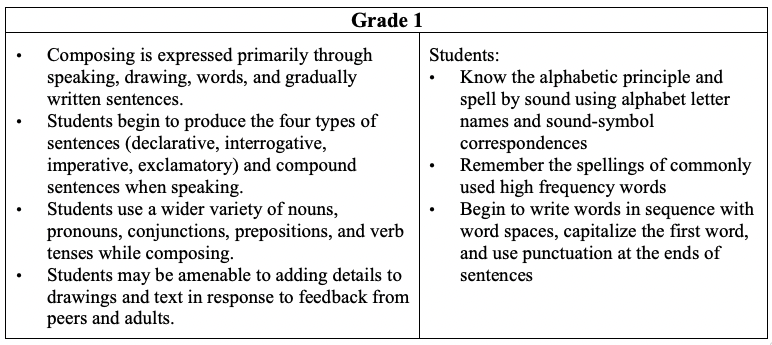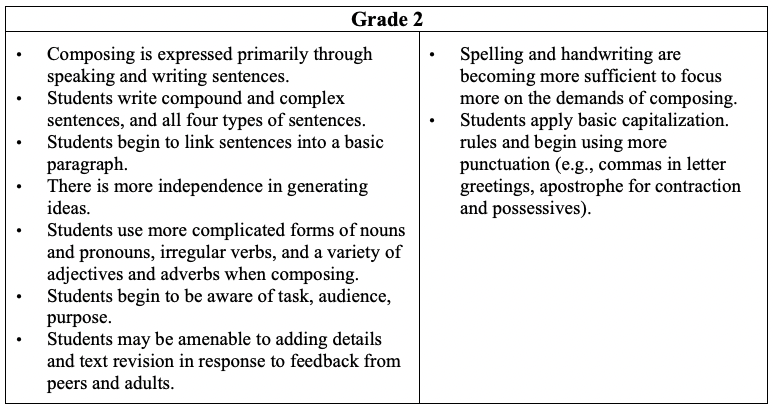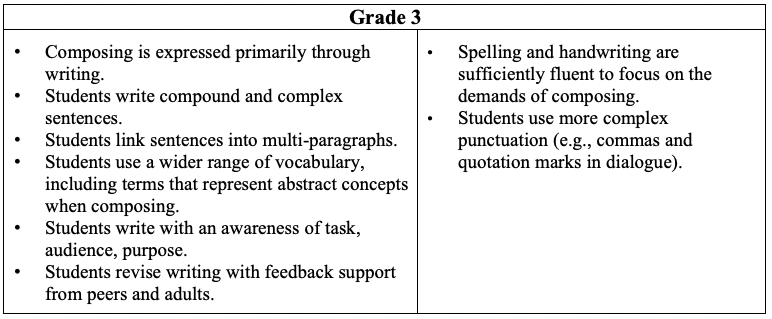Beginning Writing: Transcription vs. Composing Skills

Transcription skills include spelling and handwriting, basic skills that are needed to transcribe the words a writer wants to put into writing. For students in upper grades, keyboarding in place of handwriting is also a transcription skill. Once students become automatic and fluent with spelling and handwriting, they can focus their attention on higher level composing. If students do not develop fluency with these skills by grade 3, this will put a constraint on writing development as they move into the later grades. One of the four main recommendations in the Institute of Sciences research guide Teaching Elementary Students to be Effective Writers (Graham et al., 2012) is to teach students to become fluent with transcriptions skills, including teaching young writers how to hold a pencil correctly and form letters fluently and efficiently, and to spell words correctly.
Spelling
In the primary grades (kindergarten through grade 3), students need to learn about orthography — how the English writing system works. This means teaching that letters and letter patterns represent the sounds of spoken English, which is called the alphabetic principle. It includes instruction to develop phonemic awareness (the ability to recognize individual sounds in words), to learn phonics concepts (how the sounds can be represented with letters), and to develop morphological awareness (knowledge of prefixes, suffixes, and base words). While many teachers consider spelling a writing skill, it is best taught during a phonics lesson. Decoding (reading words) is the process of converting printed words into their spoken forms. Encoding (spelling) is the process of using letter-sound knowledge to write words. What we teach for decoding is used for spelling, and spelling reinforces decoding, which is why an effective phonics lesson should include time to use dictation to practice spelling words that include the phonics concept that is the focus of the lesson.
Handwriting
Difficulty with handwriting can have negative consequences for later writing ability. Teaching handwriting should be an essential part of a beginning writing curriculum. Stephen Graham (2009-2010) explains it this way:
“Of all the knowledge and skills that are required to write, handwriting is the one that places the earliest constraints on writing development. If children cannot form letters – or cannot form them with reasonable legibility and speed – they cannot translate the language in their minds into written text. Struggling with handwriting can lead to a self-fulfilling prophecy in which students avoid writing, come to think of themselves as not being able to write, and fall further and further behind their peers.” (p. 20)
“Young writers typically cope with the multiple demands of handwriting and composing by minimizing the composing process (planning, organizing, etc.). Because so much of their thinking must be devoted to forming legible letters, they turn composing into a knowledge-telling process in which writing is treated as a forward-moving idea-generation activity. A relevant idea is generated and written down, with each new phrase or idea serving as the stimulus for the next one. Mostly absent from this approach to writing are more reflective and demanding thinking activities such as considering the constraints imposed by the topic, the needs of the reader, or the most coherent way to organize the text.” (p. 21)
There are three main aspects of handwriting instruction: pencil grasp, letter formation using writing strokes, and legibility. For instructional suggestions, see my previous post about teaching handwriting.
Grade Level Expectations for Composing and Transcription Skills
The charts below identify grade-level expectations for composing versus transcription skills. Keep in mind that within the same grade level there can be significant differences in spelling and handwriting ability. It is therefore important to differentiate instruction to meet individual student learning needs.




This post includes wording from my book Keys to Early Writing, available at the Keys to Literacy website.
For related blog posts, see:
Additional Resources:
- Article: Encoding Explained – What It Is and Why It’s Essential to Literacy (2023) Education Week.
- Recorded Webinar: Instructional Suggestions for Beginning Phonics (2020, 48 minutes). J. Sedita, Keys to Literacy.
- Reading Rockets spelling instruction resources.
- Reading Rockets handwriting instruction resources.
- Article: Want to improve children’s writing? Don’t neglect their handwriting.
- Article: Teaching Spelling – An Opportunity to Unveil the Logic of Language (2019). L. Moats, Perspectives on Language and Literacy, IDA.
References
- Graham, S., Bollinger, A., Booth Olson, C., D’Aoust, C., MacArthur, C., McCutchen, D., & Olinghouse, N. (2012). Teaching elementary school students to be effective writers: A practice guide (NCEE 2012- 4058). Washington, DC: National Center for Education Evaluation and Regional Assistance, Institute of Education Sciences, U.S. Department of Education.
- Graham, S. (2009-2010). Want to improve children’s writing? Don’t neglect their handwriting. American Educator, Winter 2009-2010.

 Joan Sedita is the founder of Keys to Literacy and author of the Keys to Literacy professional development programs. She is an experienced educator, nationally recognized speaker and teacher trainer. She has worked for over 35 years in the literacy education field and has presented to thousands of teachers and related professionals at schools, colleges, clinics, and professional conferences.
Joan Sedita is the founder of Keys to Literacy and author of the Keys to Literacy professional development programs. She is an experienced educator, nationally recognized speaker and teacher trainer. She has worked for over 35 years in the literacy education field and has presented to thousands of teachers and related professionals at schools, colleges, clinics, and professional conferences.
Do you have any recommendations for ELs entering English speaking schools at the secondary level? Particularly those from Arab alphabets? Theres such a time crunch, but they need handwriting too.
The “ColorinColorado!” website has a helpful page of resources related to writing instruction for ELs: Elsa Cardenas-Hagan has an excellent chapter about teaching writing to ELs in her book “Literacy Foundations for English Learners” (Brookes Publishing). Claude Goldenberg has done a significant amount of work about effective instruction for ELs. His 2013 article in American Educator “Teaching English Language Learners” is a helpful resource about literacy instruction in general for ELs: https://www.aft.org/sites/default/files/goldenberg.pdf
Many schools are making the shift to using a SOR approach to literacy instruction. This means that MANY students in the older grades did not receive this type of instruction and we are seeing that students are struggling with writing. “If students do not develop fluency with these skills by grade 3, this will put a constraint on writing development as they move into the later grades.” So how do middle and high school teachers correct this along with all the other demands of the classroom? Most of these students that struggle are not flagging at-risk on universal screening measures because they have strong coping strategies. Most of the PD that is out there is geared toward elementary teachers. We can’t forget about the teachers and students that don’t fit into this category.
You make an excellent point about older students who still struggle with spelling and handwriting/keyboarding. Most likely these students also struggle with decoding, especially multisyllable words because they have not develop automatic phonics and word analysis skills. There are two parts to a response to your question. 1) They need intervention instruction to develop these skills…. Tier 2 supplemental or Tier 3 intervention instruction that will have to provided in a pull-out intervention setting. Unfortunately, in upper grades any intervention time tends to be used to help students with homework, get organized, or take untimed tests rather than actually providing instruction in skills. 2) Until they develop these skills, accommodations should be provided such as access to speech-to-text software that enables students to focus on their composing without the need to use the transcriptions skills they are lacking.